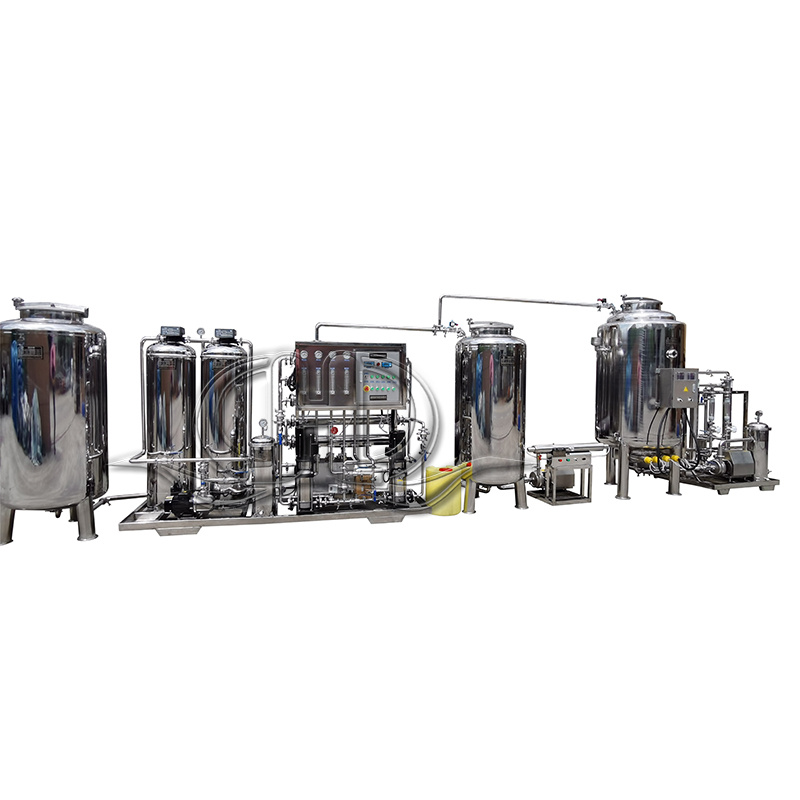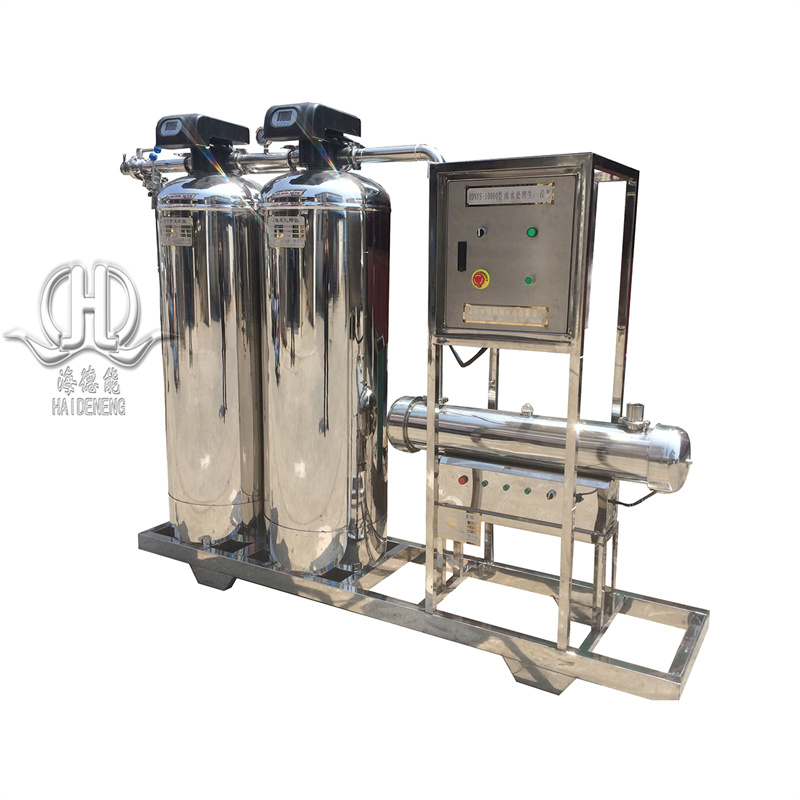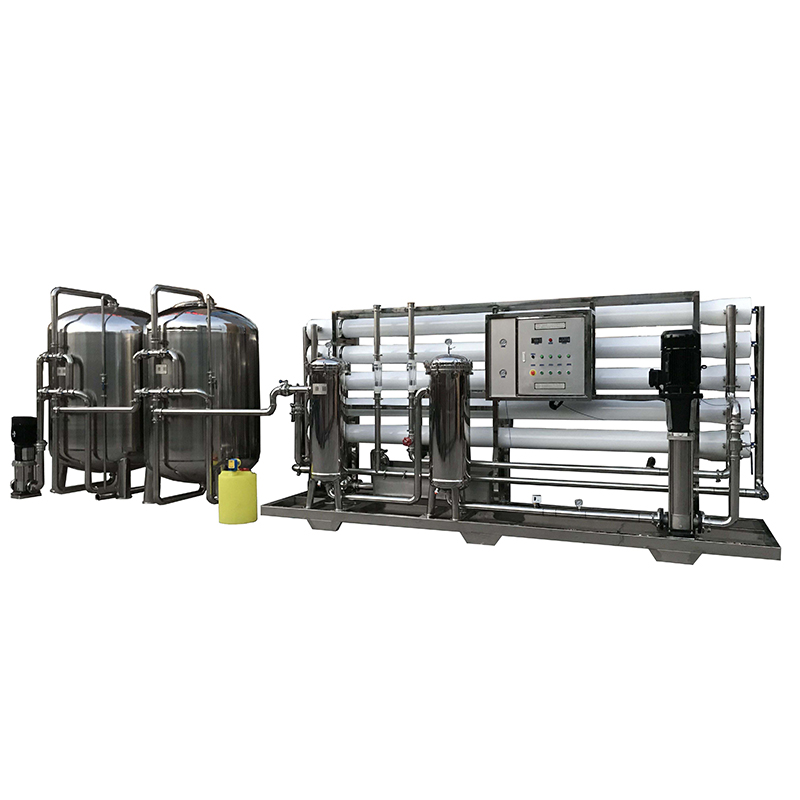Fully Automatic Reverse Osmosis Belt Softening Fine Filter Belt Water tank Water Treatment System
Product description
Technical analysis of fully automatic reverse osmosis belt softening and fine filtration belt water tank water treatment system
1、 Overall system architecture and process flow
This system is a fully automatic water purification equipment that integrates “softening pretreatment precision filtration reverse osmosis desalination water tank storage”. It achieves deep water purification through multi-level collaborative treatment, and the core process is as follows:
plaintext
Raw water → Softening device → Precision filter → Fully automatic reverse osmosis (RO) device → Pure water tank → Water point
Core functions:
Softening device reduces water hardness and prevents scaling;
Precise filtration captures fine impurities and protects the RO membrane;
Reverse osmosis deep desalination, removing dissolved salts and pollutants;
The water tank stores stable water and, in conjunction with fully automatic control, achieves continuous water supply.
2、 Key Unit Technical Principles and Parameters
1. Softening device (anti scaling core)
Principle: Sodium ion exchange resin filter belt (continuous softening technology) is used to remove calcium and magnesium ions (Ca ² ⁺, Mg ² ⁺) through ion exchange. The reaction equation is:
2R Na+Ca ² ⁺ → R ₂ – Ca+2Na ⁺ (the same applies to magnesium ions).
Technical parameters:
Inlet water hardness ≤ 500mg/L (calculated as CaCO3), outlet water hardness ≤ 5mg/L;
Fully automatic regeneration: 8% -10% NaCl solution counter current regeneration, salt consumption ≤ 100g/L resin, regeneration cycle automatically triggered with water production;
The filter belt operates continuously without interruption of water supply, with a processing capacity of 5-100m ³/h.
2. Precision filter (security filter)
Filter configuration: 5 μ m PP melt blown filter or folded filter, capable of capturing fine particles such as colloids and resin debris that remain after softening.
Core role:
Reduce the influent SDI (pollution index) to ≤ 5 to avoid scratching or clogging of the RO membrane surface;
Differential pressure monitoring (automatic alarm when>0.1MPa), filter replacement cycle 1-3 months.
3. Fully automatic reverse osmosis (RO) device (desalination core)
Membrane module: Adopting anti pollution polyamide composite membrane (such as Dow BW30FR), desalination rate ≥ 99%, single membrane water production of 0.8-1.2m ³/h.
Operating parameters:
Operating pressure: 1.0-1.5MPa (brackish water), recovery rate 60% -75%;
Conductivity of water production: ≤ 50 μ S/cm (when TDS of raw water is less than 2000mg/L);
Fully automatic control: PLC realizes low-pressure flushing (1 minute after startup), chemical cleaning (triggered by pressure difference>0.15MPa), and excessive discharge (when conductivity>50 μ S/cm).
4. Pure water tank (storage and steady flow)
Design parameters:
Material: 304 stainless steel (food grade), with a capacity of 1-2 times the system’s water production (such as a 10m ³/h system with a 10-20m ³ water tank);
Supporting equipment: liquid level sensor (low liquid level starts RO, high liquid level stops), respirator (prevents air pollution), CIP cleaning port (regular disinfection).
3、 System linkage control and automation logic
Full process linkage:
Softening device and RO linkage: When the hardness of the softened water is greater than 5mg/L, the RO will automatically stop and alarm to prevent membrane fouling;
Interlock between water tank level and RO start stop: start RO when the level is less than 30%, stop when it is greater than 80%, to avoid frequent start stop.
Intelligent protection function:
Low pressure protection: Stop when the inlet pressure is less than 0.3MPa to prevent the high-pressure pump from idling;
High pressure protection: When the pressure before the RO membrane is greater than 1.8MPa, the pressure is released to protect the membrane components;
Automatic flushing: Low pressure flushing 5 minutes before shutdown to flush away surface contaminants from the membrane.
4、 Comparison of Water Quality Treatment Effects
During the treatment stage, the raw water (typical groundwater) is softened and then subjected to precision filtration before RO water production
Hardness (CaCO3, mg/L) ≤ 500 ≤ 5 ≤ 5 ≤ 1
Turbidity (NTU) ≤ 10 ≤ 5 ≤ 1 ≤ 0.1
Conductivity (μ S/cm) ≤ 1500 ≤ 1500 ≤ 1500 ≤ 50
Residual chlorine (mg/L) ≤ 0.5 ≤ 0.5 ≤ 0.5 ≤ 0.02
Total bacterial count (CFU/mL) ≤ 1000 ≤ 500 ≤ 100 ≤ 1
5、 Technical advantages and applicable scenarios
Core advantages
Efficient anti scaling: softening+RO dual stage anti scaling, membrane cleaning cycle extended to 12-18 months (traditional system 6-9 months);
Fully automatic operation: from softening regeneration to RO flushing, the entire process is unmanned, suitable for rural areas, factories and other scenarios lacking professional operation and maintenance;
Stable water supply: water tank buffer+variable frequency water supply pump ensures stable pressure at the water point (adjustable from 0.2-0.4MPa).
applications
Industrial water:
Boiler supply water (hardness ≤ 0.03mmol/L), cooling circulating water;
Food processing (such as beverage production lines, producing water in accordance with GB 19298-2014).
Civilian water purification:
Rural centralized water supply (processing high hardness well water) and direct drinking water in residential areas;
Purification of domestic water in commercial premises (hotels, schools).
6、 Maintenance and Cost Analysis
Component maintenance content cycle operating cost (reference)
The softening device supplements NaCl and replaces the filter belt with salt every month. The replacement of salt for the filter belt every 2 years consumes about 0.1 yuan/m ³ of water
Precision filter replacement of filter element takes 1-3 months, and the cost of filter element is 0.05 yuan/m ³
RO membrane chemical cleaning, replacement cleaning takes 6-12 months, membrane replacement cost is 0.2 yuan/m ³ for 3-5 years
Clean and disinfect the pure water tank quarterly. Negligible
Total operating cost: approximately 0.35-0.5 yuan/m ³ (depending on the quality of the raw water).
7、 Selection suggestions
Small scale system (5-20m ³/h): suitable for rural villages and small factories, covering an area of 8-15 square meters, with a power of 5-10kW;
Medium sized system (20-50m ³/h): suitable for township water supply and food factories, equipped with 30-100m ³ water tanks, with a power of 15-30kW;
Customized configuration:
High residual chlorine water source: Install activated carbon filter (residual chlorine<0.05mg/L);
High turbidity water source: Add a quartz sand filter (turbidity<5NTU) before softening.
summarize
The system adopts an integrated design of “softening fine filtration RO water storage”, which takes into account scale prevention, desalination, and stable water supply, especially suitable for high hardness water source scenarios. Its fully automatic operation feature reduces the threshold for operation and maintenance, making it the preferred solution for balancing efficiency and economy in both industrial and civilian water purification fields.






